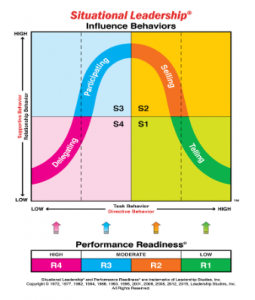Week 4: Situational Leadership Theory
One thing I have noticed with CVS Health being such a big company is that there are so many different types of leaders and with that so many different types of followers. There is no one profile that fits every CVS Health employee and I think that is what makes the company so successful at constantly innovating, rethinking, and analyzing how every decision will impact the business and its members. Something I have noticed within my own team and throughout my experience is how leaders, specifically managers and directors lead their teams and how each team requires different levels of attention and coaching. All of this reminds me of Hershey and Blanchard’s Situational Leadership Theory.
According to Hershey and Blanchard’s Leadership Studies in Situational Leadership Theory (SLT) the leader-follower relationship is based on three principles: the amount of task behavior a leader delivers, the amount of relationship behavior a leader provides, and the “readiness” level that followers exhibit (Hersey et al., 2001). The theory and its models are best explained by this detailed image:

On the left is a spectrum of supportive or relationship behavior ranging from low to high. On the bottom is a scale of task or directive behavior also ranging from high to low. Depending on where a follower lands on each of these scales, there are four larger quadrants that describe how a leader can best support their follower and help them succeed: taking on a delegating, participating, selling, or telling role.
I have always thought of myself as being high readiness. I love getting projects organized and thinking critically about problems. With that, I strive to maintain my creative touch while also producing data-driven results. Early in the internship, I made it a priority to describe this dynamic to my manager and I am very appreciative that he took this into account when creating my project plan. After talking to some of the other interns throughout the summer however, it sounded like some of them did not mesh as well with their managers or how their managers decided to structure their project plans. Some interns felt like they had too much work, others felt like they did not have enough. Obviously, it is incredibly challenging to get a true sense of a manager’s leadership style or an intern’s more follower-like style with in just 10 weeks (and even more challenging communicating through a screen), but I think I definitely had an upper hand when trying to navigate my relationship with my manager because of all the leadership theories and models I was able to apply while reflecting on our relationship.
I would most closely consider myself to be on the high relationship, low task orientation (R3). I think the application of this leadership theory and this reflection on my time at CVS Health demonstrates its importance in the world of leadership studies because I would also most closely consider my manager’s leadership style to a participating style. An R3 follower can be described as “able but unwilling or insecure” and this was pretty much me to a T. I knew I had the skills to be able to produce great projects and creative suggestions for the business, but I was incredibly insecure about how my manager would respond to my suggestions or if they would be strong enough for him to implement. In the end, my manager’s participating coaching and leading style encouraged me to stick with the projects and continue working hard on more suggestions for the team. Referring to Hershey and Blanchard, a high relationship-low is classified as “participating” because the leader and follower share in decision making and communication and facilitation as a result of the follower’s ability and knowledge to do the task.
I felt incredibly included and welcomed on the team from day one, I felt like my opinions and suggestions about the business were valued and heard and most importantly, I felt a sense of leadership and mentorship that I came into the internship searching for. I learned so much along the way, but I learned the most from my manager and his work: both being a leader of a team but also a leader in the enterprise as someone who really empowers their followers to be self-sufficient, high-performing colleagues who are proud of the work they do every day.
Given the situation with COVID and my internship being virtual, I was nervous about being able to build a genuine relationship with my peers and my manager, but through a combination of reflections, leadership analysis and applying my leadership knowledge to different situations, I feel I was able to make lots of genuine connections with colleagues all around the enterprise and I hope to continue those relationships into the future.
